The MSI MPG A1000G PCIE5 PSU Review: Balance of Power
by E. Fylladitakis on February 2, 2023 1:00 PM EST- Posted in
- Cases/Cooling/PSUs
- PSUs
- MSI
- 80Plus Gold
- ATX v3.0
- 12VHPWR
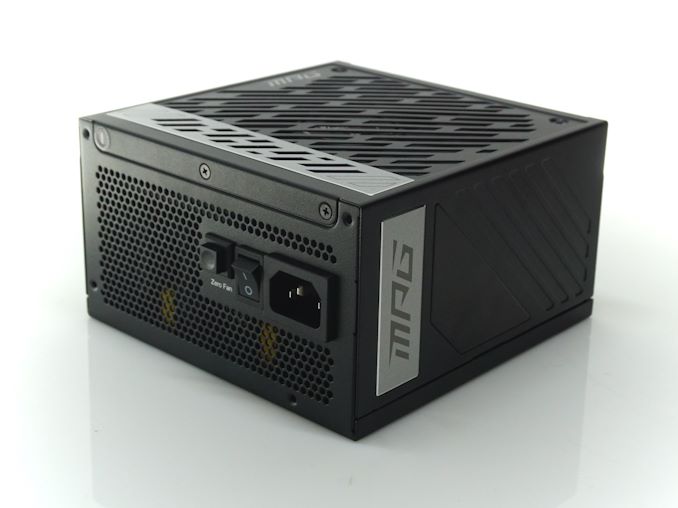
Back in December, we had the opportunity to take a look at MSI's MEG A1300P power supply, the company's latest flagship PSU. Besides offering plenty of power, the MEG Ai1300P was also MSI's first ATX 3.0 power supplies – and one of the first ATX 3.0 PSUs on the market overall. And while it was admittedly not a groundbreaking design overall, it was still a seminal work of sorts, sketching out a rough picture of what we should expect from other ATX 3.0 PSU designs, including MSI's own.
The MEG Ai1300P was a true flagship PSU, for all the pros and cons that come with that. As impressive as it was overall, it was also aimed at those willing and able to deal with the hefty price tag. This is all well and good for the small fraction of the market that can afford such a high caliber PSU, but for most PC builders, budgets are a very real thing.
So, for today’s review, we are taking a look at something a little more downmarket from MSI: their MPG series. Like their flagship units, the new MPG PSUs are also are ATX 3.0 Ready, but they come at more reasonable prices. Despite that shift, the unit we're testing today, the MPG A1000G, is still one of the most powerful PSUs MSI offers (as well as being the top MPG unit), capable of delivering a kilowatt of PC power.
| MSI MPG A1000G PCIE5 Power specifications ( Rated @ 50 °C ) |
|||||
| RAIL | +3.3V | +5V | +12V | +5Vsb | -12V |
| MAX OUTPUT | 22A | 22A | 83.5A | 3A | 0.3A |
| 120W | 1000W | 15W | 3.6W | ||
| TOTAL | 1000W | ||||
| AC INPUT | 100 - 240 VAC, 50 - 60 Hz | ||||
| MSRP | $199 | ||||
All of this marks a rather rapid ascent in the PSU space for MSI. The company released its first PSU just two years ago with the MPG GF series, which were primarily designed for gaming computers. Even though MSI stepped into a highly competitive and rather saturated market, the release of the MPG series was yet another success for the company, which MSI is hoping to further build upon with their new PCIE5-branded MPG units.
Packaging and Bundle
We received the MPG A1000G PCIE5 in a sturdy cardboard box with basic geometric artwork printed on it. The front of the box is mostly occupied by a picture of the unit itself but abundant information is printed on the sides and rear of the box. Inside the box, the unit is well-packed inside soft packaging foam, ensuring safe shipping.
The bundle of the MPG A1000G PCIE is extremely frugal, with MSI supplying only the necessary AC power cable – ours came with a matching Schuko cable for our region – as well as four black mounting screws. There are zero accessories of any kind supplied with this unit.
The MPG A1000G PCIE PSU is a fully modular design, allowing for the removal of every DC power cable, including the 24-pin ATX connector. Most of the cables have individually sleeved black wires and with black connectors. Only the 16-pin PCIe 5.0 cable and one cable with two PCIe 8-pin connectors have black wires but are wrapped in a single sleeve.
| MSI MPG A1000G PCIE5 | ||
| Connector type | Hardwired | Modular |
| ATX 24 Pin | - | 1 |
| EPS 4+4 Pin | - | 2 |
| EPS 8 Pin | - | - |
| PCI-E 5.0 | - | 1 |
| PCI-E 8 Pin | - | 6 |
| SATA | - | 12 |
| Molex | - | 4 |
| Floppy | - | 1 |
The MSI MPG A1000G PCIE 1000W PSU
External Appearance
MSI is a company that invests a lot of resources in the external appearance of its products and that includes its PSUs. Much like the MEG series unit that we reviewed a few weeks back, the MPG series is using a proprietary chassis with embossed geometrical shapes. The design is very similar to that of the MEG series but not quite the same – the golden accents are now silver and some geometrical decorations differ, with the MPG having only rectangular patterns and no triangular shapes. The PSU is just 150 mm long, making it only slightly longer than what the ATX standard dictates, yet it remains short enough to ensure its compatibility with all but the smallest ATX-compliant cases.
The sticker with the unit’s electrical certifications and specifications can be found on the otherwise plain top side of the PSU. Decorative silver and black metallic plates can be found on the sides of the unit, which plates are magnetically attached and can be flipped to match the installation orientation of the PSU.
At the rear side of the unit, right next to the AC power connector and the basic on/off switch, there is a latching push button that controls the “zero-fan mode”. As the name suggests, this mode allows for passive operation while the PSU’s load is low – a frequently applied technique by many manufacturers nowadays. Disabling it will force the fan to continuously spin as long as the PSU is powered on, but its speed will still be controlled thermally.
The front side of the unit is host to the numerous connectors for the modular cables. A subtle legend is printed directly on the chassis.
Internal Design
The cooling fan of the MPG A1000G PCIE5 is a 135 mm model by Hong Hua, a rather popular manufacturer whose fans we frequently see in quality PC PSUs. The HA13525H12SF-Z is a fan that satisfies the cooling needs of the MPG A1000G PCIE5, though it is a very high-speed fan for its size, with a maximum speed of 2300 RPM. It has a fluid dynamic bearing (FDB) engine that provides excellent longevity.
The OEM whose platform the MPG A1000G PCIE5 is based upon is Channel-Well Technologies, or CWT. CWT is a popular OEM for mid-to-high performance PSUs and they also are the OEM behind MSI’s flagship MEG series. The MPG A1000G PCIE5 is based on a different platform than that used for the MEG series, which seems to be an upgraded version of one of the CWT’s most popular platforms. This platform has been the heart of many units having a similar power output over the past few years. In order to fit the 135 mm fan in the 150 mm chassis, CWT cleverly shortened the vertical daughterboards to provide enough clearance.
Overall, the MPG A1000G PCIE5 looks very crowded because of its very high power density - the layout is fairly simple. The filtering stage is typical, with four Y capacitors, two X capacitors, and two filtering inductors. The filtering stage leads to two large rectifying bridges, which are placed on their own sizable heatsink. The passive components of the APFC circuitry are a humongous 400V/820μF APFC capacitor Nichicon and an equally large encased filtering inductor. The active APFC components are on the longest heatsink of the unit.
Two transistors can be found on their own heatsink, forming a typical half-bridge inversion topology on the primary side of the unit’s main transformer. The output of the main transformer is connected to eight power MOSFETs that generate a single 12V rail, which is placed on a vertical daughterboard. The 3.3V and 5V lines are being generated via DC-to-DC conversion circuitry that can be found on the subsequent vertical daughterboard. The secondary side capacitors are all made by Nippon Chemi-Con and Nichicon, or their subsidiary companies, making this PSU an all-Japanese affair.


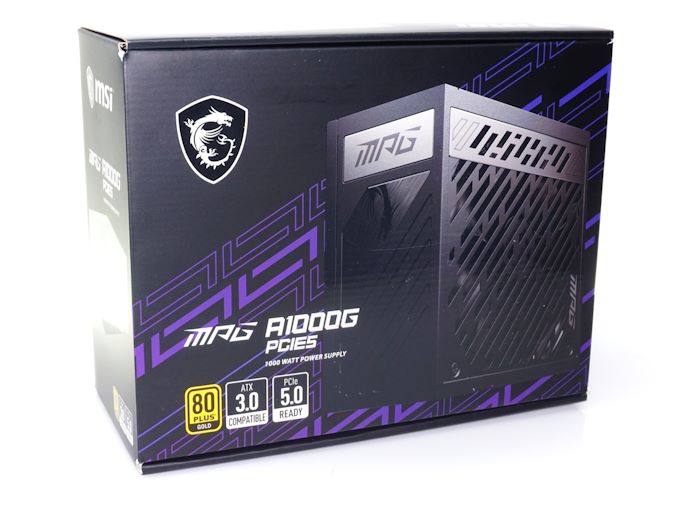

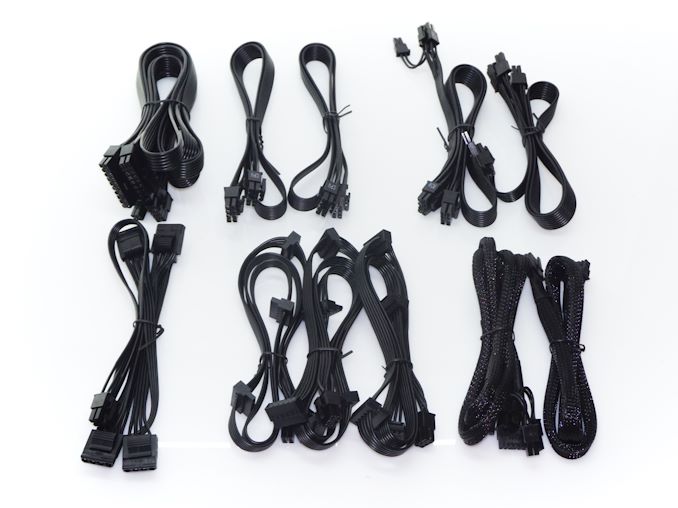
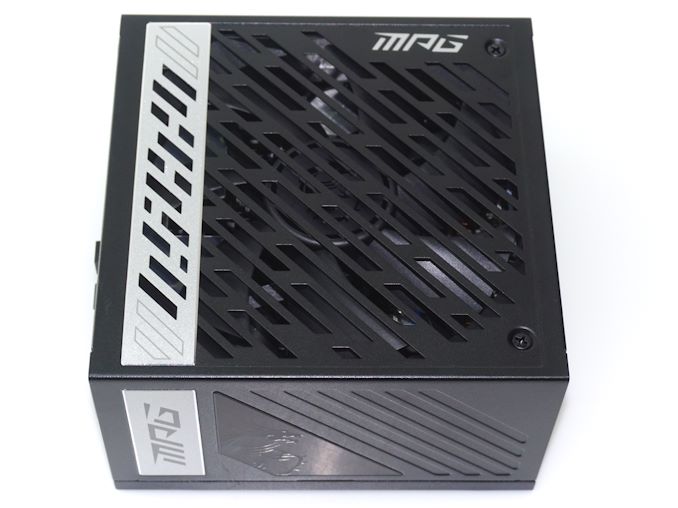
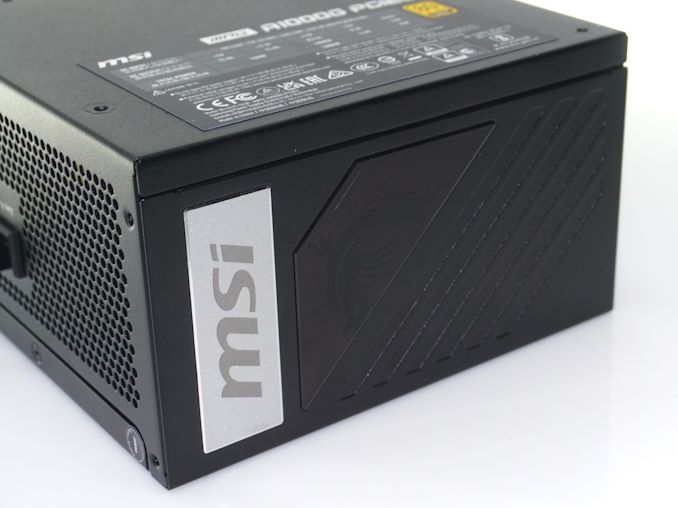
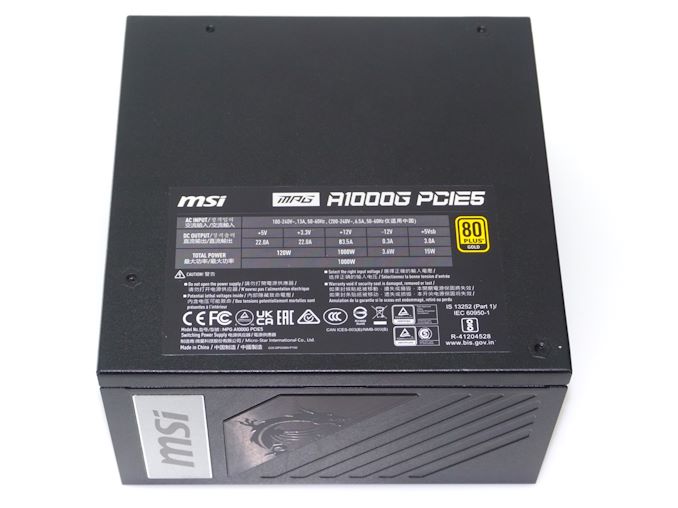
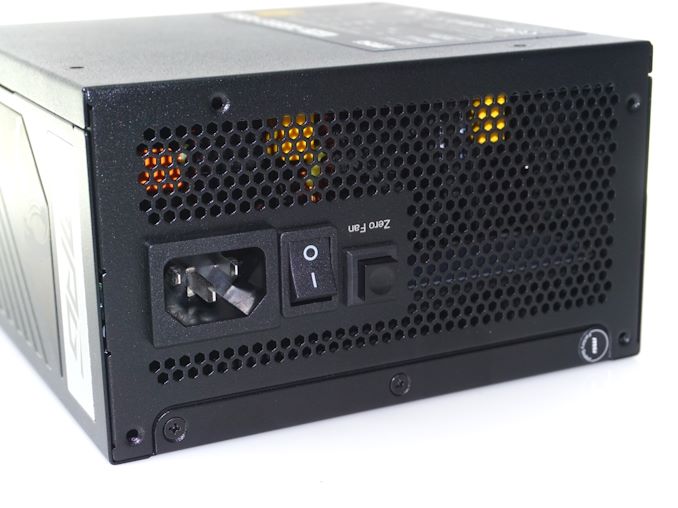
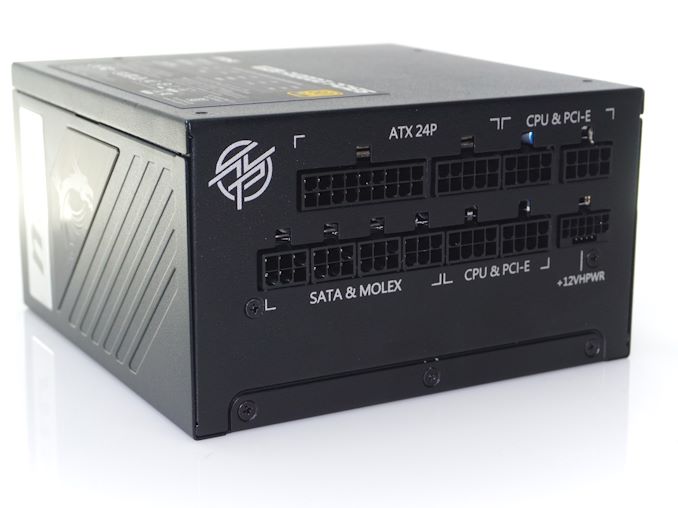
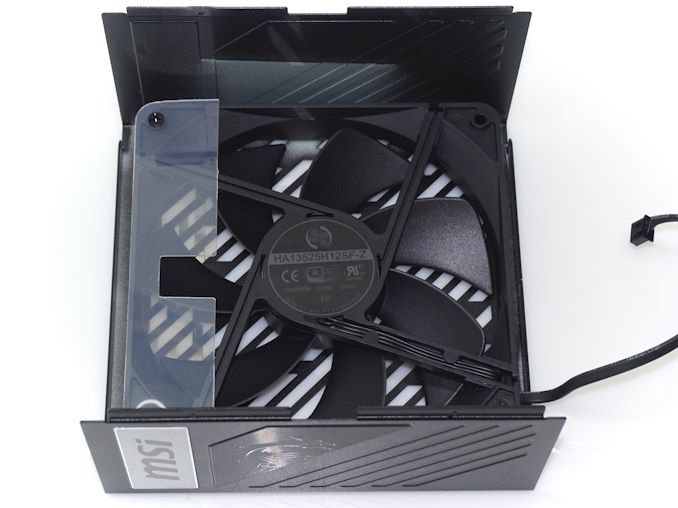
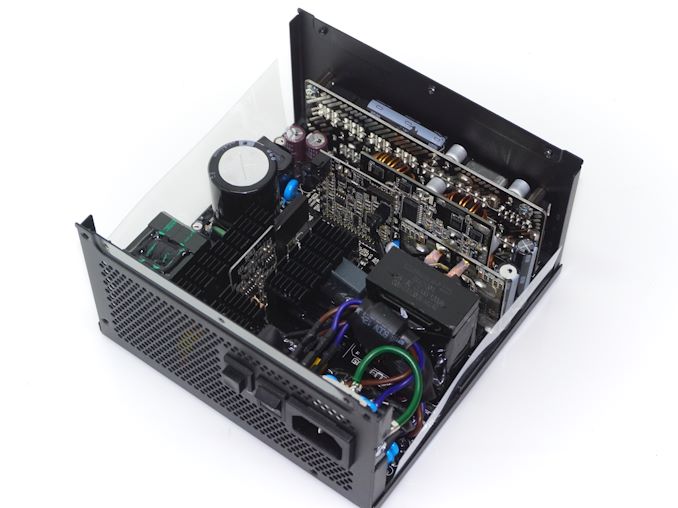
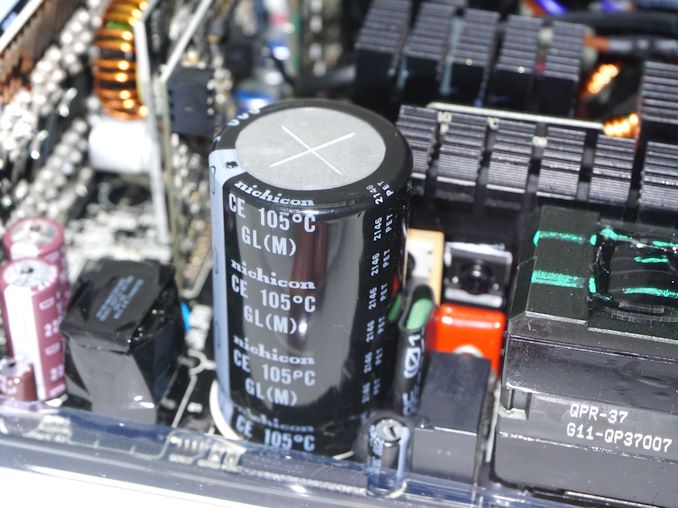
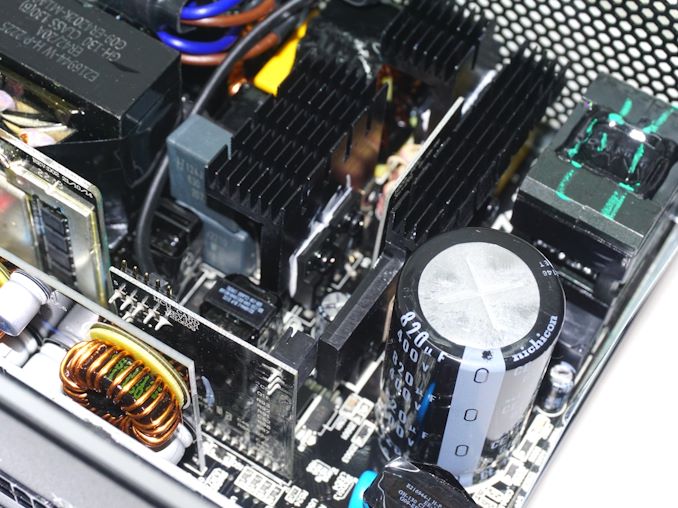

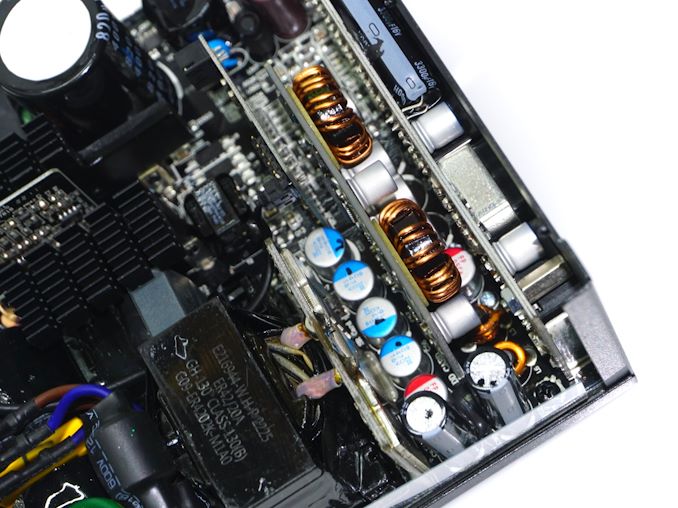








15 Comments
View All Comments
sparkuss - Thursday, February 2, 2023 - link
Picture is of a 220V spec cord. Is that the only cord it comes with or will US Market items have 110-120V cords?DanNeely - Thursday, February 2, 2023 - link
It's a europlug because E. Fylladitakis lives there. The whole reason behind detachable power cords is so that you can switch in the one appropriate for the market it's being sold in. Unless you're buying from a gray market importer it shouldn't be an issue. And unlike UPSes, where the difference in plug sizes can impact how many outlets are available it should work identically.Order from Amazon.de and get that plug, order from amazon.com and get a 5-15 plug.
PeachNCream - Sunday, February 5, 2023 - link
Its also very easy to source the correct wall outlet cable in the US. There are many millions of those lying about the States due to how many desktop PCs there once were and how few currently remain in daily use after the desktopoclypse when laptops took over as primary PCs more than a decade ago along with the fact that said cables are still in production. There's quite the oversupply presently.eriri-el - Tuesday, February 7, 2023 - link
You do know that those are standard called C13 on the cord side and C14 on the PSU side respectively. These are used in many many electrical appliances, for a very long time before computers became a household norm, not just computers. You should look at the behind of all of your appliances in your house more often. There is alot of them in the market because many people use them for many things, not just computers.atragorn - Friday, February 3, 2023 - link
Is it user selectable whether it is 240 or 120 or is it based on the market it is purchased in ?If I buy in the US can I change to 240 is what I want to know.
Also the efficiency will be lower with a single phase 120 line. Is it possible to test that unless it's a European only power supply?
It can be very different possibly.
meacupla - Friday, February 3, 2023 - link
The PSU has an auto-switch, and can handle 100VAC~240VAC 50Hz/60HzIf you buy in North America, to use 240VAC, you should first check if you have a spare 240VAC outlet to begin with, and then check which type it is. There are a few different NEMA
Then you can get a "NEMA (insert plug type) to IEC C13 Power Cable"
temps - Friday, February 3, 2023 - link
Bought one of these to power my rig before any reviews were out... it's nice to see it measures quite well and is actually very efficient in the range my computer spends 99% of its time in.Strange though, my PCIe 5.0 cable was round wound and not flat like this one was. It was the only round cable in the box.
jb14 - Friday, February 3, 2023 - link
I have one of these on order for a rig, to power a MSI 4090 and an i5 13600K + AIO cooler. I'm trying to keep the noise down but see here that at 800W+ (where I may reach gaming) it is annoyingly loud.Can anyone recommend another 1000W PSU which is similar in quality with 12VHPWR, but is quieter at higher wattage? Many thanks
dpenda - Saturday, February 4, 2023 - link
The Bequiet Darkpower 13 seems to fit your request. The Seasonic vertex also seems promising although no reviews out yet. You might also consider going to higher wattage - a less stressed power supply will keep Dan noise down.jb14 - Sunday, February 5, 2023 - link
Yes, I came across the be quiet 13 later and see it's just been released so missed it first time round. The reviews are good so have made the switch to it. Thanks